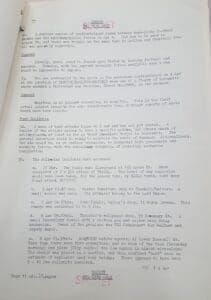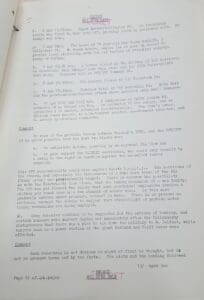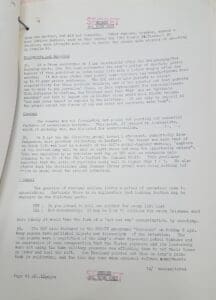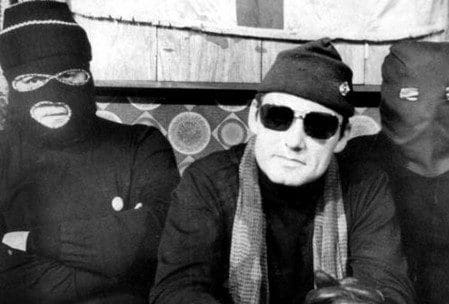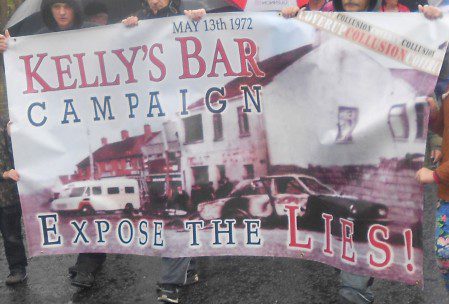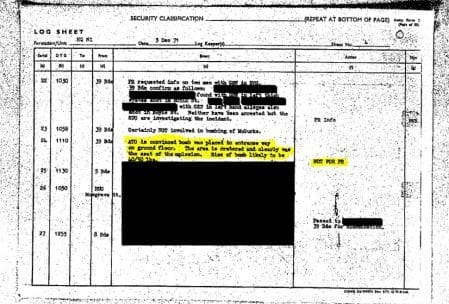False Flag Bombs of British extremists covered up by the British state.
March-April 1969: a series of bomb attacks on the electrical and water infrastructure of Northern Ireland were blamed on the Irish Republican Army (IRA). They were actually false flag attacks carried out by Loyalist members of the Ulster Volunteer Force (UVF) and the Ulster Protestant Volunteers (UPV), closely associated with the sectarian firebrand, Reverend Ian Paisley.
The state broadcaster (BBC Spotlight) alleged that Paisley helped finance the bombings, never mind providing cover for them and politically benefitting from them.
In the words of the Northern Ireland Prime Minister Terrence O’Neill, the bombs “literally blew” him out of office at the end of April 1969.
The planners also aimed to discredit the Civil Rights movement, provoke a hardline Unionist response against O’Neill’s modest reforms, and enflame the usual fear about the IRA, which had limited capacity at the time.
False Flag 1969
The UVF began bombing the Republic of Ireland in August 1969 but only when Kilkeel UVF/UPV member, Tomas McDowell, electrocuted and mortally wounded himself whilst trying to bomb an electrical substation in Ballyshannon, County Donegal, in October 1969 did it become public knowledge that the UVF had been the perpetrators of these bombs and the bombing of the Northern Ireland infrastructure in the months before.
The bombs worked and we know what happened in the interim period since they toppled O’Neill – sectarian marches, police violence, communal rioting, and British Army boots back on the streets of Northern Ireland.
The conflict had started in earnest, but there was an alternative at the time.
Paper Trail has discovered unredacted British Military intelligence files from the following year, 1970, that show that British commanders believed that a series of bomb attacks targeting so-called “moderate” Unionist politicians, businesses and even an elderly Protestant woman were not the work of the IRA, but again false flag bomb attacks by the UVF that lay unclaimed and/or were blamed on the IRA.
Whilst this particular series of explosions continued a pattern of attacks on moderate Nationalist and Liberal politicians such as Austin Currie, Sheelagh Murnaghan and New Ulster Movement (the Alliance Party of Northern Ireland launched in April 1970), they remain important as they occurred at a time of terrible communal violence, they targeted so-called “moderate” Ulster Unionist leaders in the throat of local Stormont and national Westminster elections and arguably greatly impacted the results which changed the course of Northern Irish history.
Again, the British military recognised that the aim of the UVF bombers:
“… could be, as on earlier occasions, to discredit both government and security forces, with the subsidiary intention of promoting sectarian tension.”
The intention was similar in 1966 when the UVF fired through the door of the Shankill home of hardline Unionist MP, John McQuade, in April 1966 with the aim that the attack was blamed on the IRA.
4 years later, in a major electoral upset for the Orange state’s Ulster Unionist Party, hardliners of the Protestant Unionist Party, the Reverend Ian Paisley and William Beattie, gained Stormont seats. Paisley won the seat vacated by Terence O’Neill when he took a peerage to the House of Lords. Paisley then won the Westminster election for North Antrim in June 1970, beginning a national political career that spanned generations and lasted until 2008.
The negative and positive impacts of Paisley on the history of Northern Ireland will be debated for generations to come. Hopefully, we will learn more about his deep connections to Loyalist paramilitarism and violence so future generations can properly measure these too against the sectarian and violent history of the statelet.
Paisley’s close confidantes and UPV colleagues were involved directly in the bombs, he gave lifts to the likes of UPV/UVF Noel Doherty and UVF Billy Mitchell to meetings with police officers to secure explosives, and in 2019, BBC Spotlight alleged that Paisley actually supplied money to the UVF to fund the bombings in 1969, whilst he himself was in prison for unlawful assembly.
Paisley and the Battle of Ballymurphy
Aside from close dealings with loyalist paramilitaries throughout his career (including the likes of the Ulster Workers’ Council Strike of 1974 and United Unionist Action Council Strike – or “Paisley Strike” – of 1977), Paisley had a long history of direct involvement with setting up loyalist paramilitary groups from as early as 1956 and the setting up of Uster Protestant Action (UPA). Paisley’s Ulster Protestant Volunteers (UPV) followed in 1966. His Third Force followed in 1981 and the DUP’s paramilitary wing, Ulster Resistance, in 1986. British intelligence helped re-arm Ulster Resistance and the other main loyalist paramilitary groups, UVF and UFF, in the late 1980s, but Ulster Resistance has never decommissioned its share.
Paisley denied any connection to loyalist violence throughout his career.
The British Army in these 1970 files makes the connection between Paisley and loyalist paramilitary violence, though.
Orange marches, intercommunal violence, and displacement in Ballymurphy, New Barnsley, and Springmartin areas were the grim backdrop at the beginning of April 1970. Paisley was in the thick of it from the 1st April and “demanded” an interview with the Commanding Officer of the British Army regiment in the area, 1st Battalion Royal Scots. The British Army files that Paper Trail uncovered also recorded Paisley’s threat that: ‘If he was not given satisfaction:
“He would bring down the SHANKILL boys to BALLYMURPHY tonight.”
1 RS sought guidance from Brigade.

Brigade’s Military Intelligence Officer recorded later that:
“Paisley has rung the commissioner to say he is worried about the area. If military do not take action, he will bring prot [Protestants] from all over Belfast to defend the area.”
Crowds on either side began gathering again around 8pm with the return of the New Barnsley Orange parade and they were throwing bottles and stones within the half hour. The situation deteriorated until the British Army moved reinforcements in from nearby battalions.
By 1129pm that night, though, 1 RS reported:
“Sit [Situation] is in 2 distinct parts. Divis Moor [Divismore] steps – quiet. S’martin [Springmartin] – active.”
The Catholic part of the road was quiet, whilst the Protestant side was active.
The British Army deployed A Company 1st Battalion Light Infantry to Divismore to Support B Company 1 RS units there and it was A Coy 1 LI that is first reported as having thrown gas grenades at 2344 hrs. 1 RS reported that it checked on gas and the area was quiet at 2357. 5 minutes later, B Company reported it was now using gas too against the Catholic area.
That is how the gassing of Ballymurphy began.
Brothers-in-Arms: The Parachute Regiment and the UVF
Major MF Timmis compiled a “Secret: Military Eyes Only” British Army Intelligence Summary (INTSUM) for the period for the Brigade Commander of 39 Brigade, who was in charge of the British Army in Belfast and Greater Belfast. The INTSUM records a report from the 2nd Battalion Parachute Regiment (2 Para) then covering the Shankill area on the night of 2nd April:
“5 truck-loads of armed personnel UVF were to move to Ballymurphy that night… Most of these were ex-servicemen… Weapons to be used included .38 and .45 revolvers.”
The UVF was a proscribed organisation, of course, but rather than arrest them:
“2 Para were able to dissuade the organisers from their lawless but pro-military intentions, at least for the time being.”
The Paras intelligence was from a named source that “was confirmed as a UVF group 2i/c [Second-in-Command] who claimed: “a personal Command of 40 men, and on-call strength of 500.”
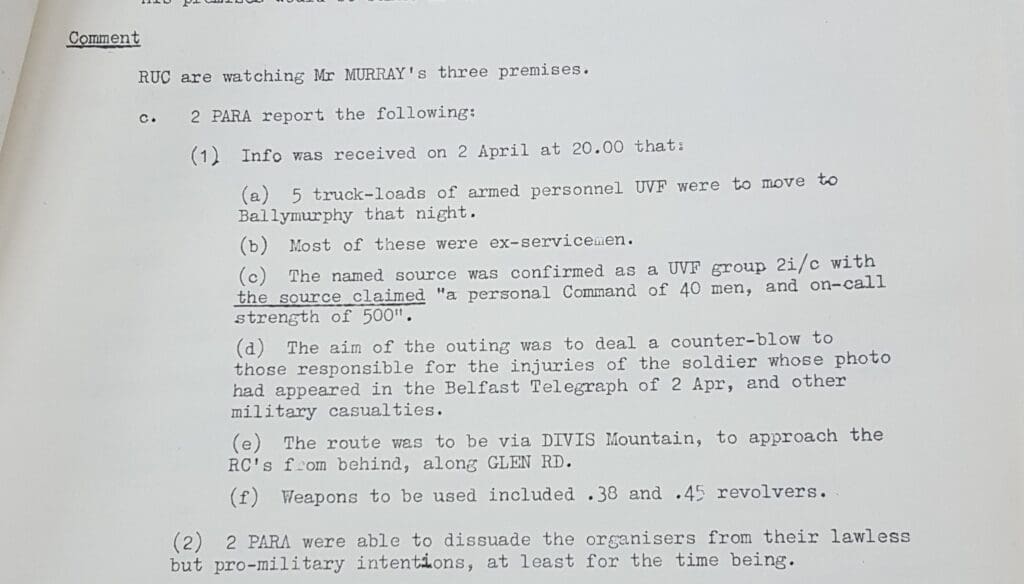
It appears from the British Army INTSUM that 2 PARA were not happy – but not for reasons that some readers may suspect. 2 PARA commented:
“a. Main issue was outrage at the situation in which army personnel currently found themselves.
b. This section of the UVF is clearly well organized, with the majority of its members ex-servicemen. Arms are available. Discipline is firm – this is borne out by the successful calling-off of a paramilitary operation under emotional duress.
c. In view of the awareness along the Peace Line that the injury of any soldier of the PARA Regiment will bring strong UVF reprisals, it is probable that many of this area’s ex-military membership are ex-Airborne Forces.
d. This particular UVF [British Army emphasis] group is unlikely to carry out acts of sabotage.”
2 PARA had decided that this was the pro-military , well-organised, and armed friendly UVF.
A series of bomb attacks began the following day in the Shankill, which British Military Intelligence posited were the work of the local UVF.
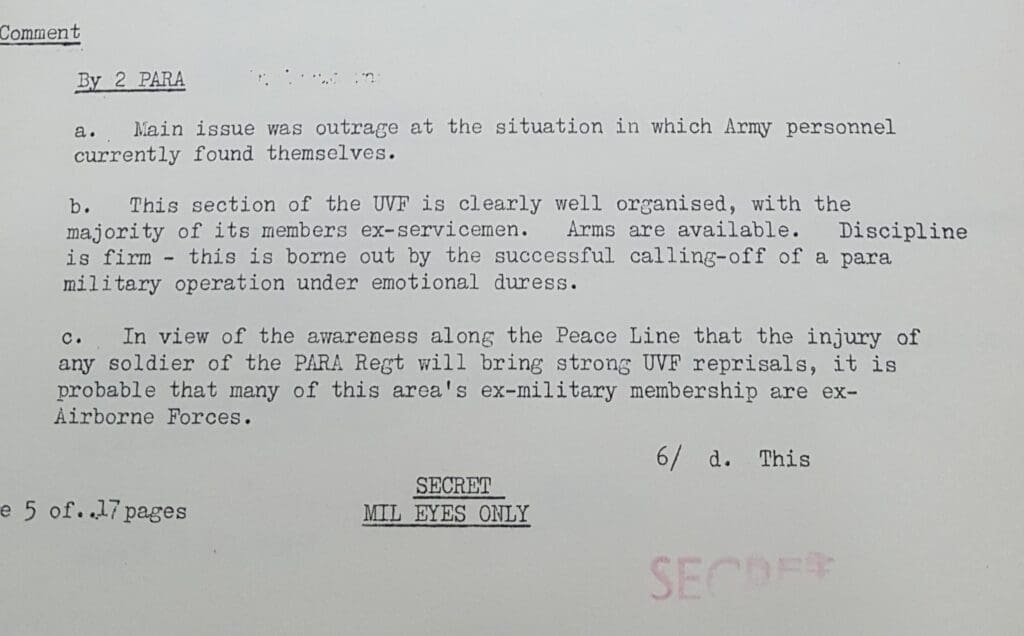

Continued below >>>


Flase Flag 1970
The British Military Intelligence Summary records:
“A wave of bomb attacks began on 3 Apr [April] and has not yet abated. A number of the attacks appear to have a specific motive, but others smack of arbitrariness, at least as far as their immediate target was concerned. The general intention could be solely to maintain the state of tension. Alternatively the aim could be, as an earlier occasions, to discredit both government and security forces with the subsidiary intention of promoting sectarian indignation.”
It then lists the wave of bomb attacks beginning with one against Eagle Taxis in the Shankill, which was last attacked by the UVF in January as it was then Catholic-owned:
“a. 27 Mar. Two bombs were discovered at 145 Agnes St. Each consisted of 2 x ½ lb sticks of UNIGEL. The brunt of any explosion would have been taken, for the second time, by EAGLE taxis next door (last attack 26/1/70)
b. 3 Apr 23.40 hrs. Cairns furniture shop at Shankill/Malvern. A small device was used. The premises belong to the Lord Mayor.
c. 4 Apr 04.50 hrs. John Temple, tailor’s shop, 74 Royal Avenue. This charge was estimated to be 5 lbs.
d. 4 Apr 09.20 hrs. Christie's wallpaper shop, 55 Rosemary St. A small incendiary device with a clothes peg and solder wire delay mechanism. Owner of the premises was USC Commandant for Belfast and Deputy Mayor.
e. 4 Apr, 09.30 hrs. McQUOIDE [sic] estate agents, 47 Lower Donegall Street. This time there were five casualties, and in view of the time (Saturday morning) and place (City centre) the low number is almost miraculous. The charge was placed in a dustbin, and this confined "seat" made an estimate of explosive used very tricky. There appears to have been five to 10 lbs of gelignite involved.
f. 4 Apr, 13.25 hrs. Upper Queens/Wellington St. An incendiary device was found to have gone off, probably fired by sulfuric acid. No damage was done
g. 5 Apr, 0445. The house of 78 year-old Miss, Mrs. Clara McGRATH, 3 Ballyclare Street. No known motive, unless (as at paragraph 34 above) to provoke local ill-feeling with the old tactics of attacking elderly, young, or infirm.
h. 5 Apr, 23.36 hrs. A device placed in the doorway of VAC Services, an electrical shop, damaged both this store and the DIOR hairstylists next door. Premises were at 285/287 Tennent Street.
i. 6 Apr, 22.30 hrs. The General Stores at 137 Woodstock Road
j. 6 Apr, 22:30 hours. Parkview Hotel at 166 Ravenhill Road. Both this and the previous/simultaneous attack above involved only small damages.
k. 11th of April, 0110 and 0245 hours. Two explosions at 78-82 Antrim Road, premises of J. Morgan and Son. An estimated 10 lbs of charge and an estimated 2 lb charge, detonated electronically. The firm's owner, William James Morgan, is a Protestant senator, ex-Stormont minister, and S. Antrim by-election candidate.
COMMENT
In view of the probable tie-in between Paisley's UCDC and the UPV/UVF, it is quite possible that the last two blasts were
- to intimidate Morgan, possibly by an apparent IRA blow, and
- to gain support for PAISLEY candidates who could only benefit by a swing to the right in reaction against the so-called terror campaign.
This UPV responsibility could also explain blasts b, c, g, I, j.. The locations of the others, and especially the viciousness of e, make more sense if the IRA Brady group are provisionally blamed.”
Of the remaining, the premises at (d) belonged to William Christie of the Ulster Unionist Party, who subsequently was Lord Mayor of Belfast from 1972 – 1975 and so fitted the pattern of attacks against officials of the ruling Unionist party in this bomb wave. These attacks included the attack on the Unionist Mayor’s premises (b) and (j) the double bomb attack on the premises of William Morgan, the ex-Stormont minister and William Beattie’s opponent to the South Antrim seat.
The bomb attack at McQuoid’s (e) resulted in 5 casualties but could have resulted in many more. Its “viciousness” and the locations of the remainder “make more sense if the IRA Brady [Provisional IRA] are provisionally blamed.”
And they were.
False Flag: Blame the IRA
An IRA statement was published in the media purporting to be from the “Provincial Army Council” [sic] (Belfast Telegraph 7th April 1970) and claiming (c) the bomb at John Temple’s tailor’s shop. It was signed by a “Padraig Walshe, Commandant”. It was patently nonsense and the “Provisional Army Council” of the IRA in Dublin disclaimed it as a bogus statement (Belfast Telegraph 8th April 1970):
“The Irish Republican Army disclaims all responsibility for this action and the issuing of such false statement is highly irresponsible in the present circumstances”
“We would like to remind news editors and journalists that all authentic statements from the Provisional Army Council will be issued on paper headed ‘Irish Republican Publicity Bureau’ and will be signed ‘P. O’Neill’”
None of this explosive British Military Intelligence was published in the media, of course. At best, articles at the time were framed in such a way that the bombs were lumped in with news about trouble in the Catholic estate of Ballymurphy and IRA threats to kill British soldiers, following threats by the British Army’s General Officer Commanding that his troops would shoot dead any petrol bombers.
Stormont doubled the reward for information on the bombers to £10,000 on 6th April and again the news was wrapped up in content directed against “IRA terrorists”. The reader would naturally infer that the bombs were the work of the IRA, fears that were directly amplified by Protestant newspapers such as Paisley’s Telegraph. Hours after Stormont’s decision to double the reward, two bombs exploded in Protestant east Belfast (i, j) – again, these are bombs attributed by British military intelligence to Loyalists in their own area.
On Tuesday 7th April an emergency debate was held at Westminster and Gerry Fitt MP – no friend of the IRA by any stretch – argued:
"What has brought about the debate is a series of explosions, particularly over the past week and, indeed, over two years. The tone of the speech of the hon. Member for Belfast, South and of the article in The Times today suggests that these explosions are the handiwork of the I.R.A., a subversive organisation intent on causing explosions. But that is not so and there is no one here or anywhere else who can point the finger of accusation at the I.R.A. But what we do know is that the explosions early in 1969, in March and April, were the work of the illegal Ulster Volunteer Force, an extreme Right-wing Unionist organisation with which, to my mind—although he has publicly said that he had nothing to do with it—the Rev. Ian Paisley has a close connection.
It would be generally accepted, even by those hon. Members opposite from Northern Ireland who are opposed to me, that those explosions were caused with the intention of bringing about the downfall of the Northern Ireland Government and particularly of Captain O'Neill."
British Military Intelligence agreed with Fitt.
As an aside, the INTSUM also records:
“Many theories continue to be suggested for the pattern of the bombing, and certain rumours were current during and immediately after the Ballymurphy disturbances that there was a plot to tie down the military to W. Belfast, while targets such as a power station or the giant Harland and Wolff crane were affected.
Comment
Such reasoning is not devious as might at first be thought, but is not at present borne out by the facts. The riots and the bombing followed upon one another and did not coincide. Other rumours, however, served a more obvious purpose, such as that during the 1969 Hooker St/Disraeli St troubles, when attempts were made to incite the crowds with stories of shooting in Crumlin Rd.”
The INTSUM records in its conclusions:
“The latest wave of explosions and the failure by the Security Forces to apprehend those responsible, continue to give cause for concern. The facts would suggest that they are primarily the work of an extreme Protestant organisation intent on inflaming the sectarian issue and on causing the downfall of the present N. Ireland Government…”

British Military leaders had little faith in the police work of the Royal Ulster Constabulary. In similar INTSUMs Paper Trail found for the month before, March 1970, Major Timmis informed his Brigade Commander:
“The lack of progress on the bomb explosions and a complete absence of worthwhile Special Branch information generally emphasises either their weaknesses, or their reluctance to impart information to the Security Forces, or both. However hard units may try to assess the situation and produce reliable information, little can be achieved without the full cooperation of S.B. at all levels and especially at the top. Furthermore, no real success can be achieved in penetrating the various subversive organisations, in particular the extreme Protestant ones, until an organised “informer” network is established. In the final analysis it can only be the ‘Irishman’ himself cooperating with S.B., who will provide the sort of reliable information upon which the Security Forces may act with some guarantee of success. In the meantime, the military continued to be seriously handicapped for lack of worthwhile information or S.B. cooperation.”

The British Army mistrust of the RUC went further. Regarding the theft of an RUC rifle on 13th March 1970, the Brigade Commander is informed:
“Yet another loss by USC [Ulster Special Constabulary], this time a rifle. It was removed from a car parked outside the TRAVELLERS’ REST public house, the USC owner of the weapon had stopped off for a drink before proceeding to guard duties at DIVIS rebroadcasting site.
Comment
An uncanny number of USC arms go missing regularly. The ‘loser’ is quite likely to be not quite ignorant of the ‘lost’ weapon’s whereabouts.”

Back to the INTSUM regarding the wave of explosions and the election the following month, the Major recorded:
“The Political scene is currently dominated by the S. Antrim [Beattie] and Bannside [Paisley] by elections on 16 April [3 days later]. The recent ‘troubles’ have undoubtedly proved beneficial to the ‘Paisley’ cause. Nevertheless, since the weekend, the signs would suggest that it will still be a close ‘fight’, especially in Bannside.”
Both Paisley and Beattie won.
The following INTSUM covering period 14 – 21 April 1970 began:
“If anyone had gone to a bookmaker and backed the Paisley and Beattie combined ticket a month prior to the election his chances of a win would have been poor…”
“The halt in the bombing wave is a welcome relief. This is probably due to the PUP (Paisley’s Protestant Unionist Party) election successes, although recent intensified efforts by the security forces to catch those responsible may have deterred the culprits temporarily.”

A stop to the attacks on Unionist politicians was only temporary as there was an explosion outside the home of ex-Unionist MP, Richard Ferguson, who had resigned his South Antrim seat earlier in the month after being expelled by his local association for being too liberal. Hardline Reverend Beattie filled that vacant seat.
Timmis concluded in his INTSUM for 21 – 28 April:
“The Stormont Government continues to be pressured by its more extreme Unionist members to adopt a harder line and to rescind a number of the pending reforms. The widening split with their party constituencies confirms the disappearance of the moderate group – if it ever existed. It seems that the Government is becoming less representative of the Unionist electorate. The death of Dr Laird will afford the Paisleyites another opportunity to infiltrate Stormont. It is hoped that the Government will remain firm and thereby promote confidence. By so doing the moderate ‘silent’majority may subsequently re-emerge. This is unlikely if known moderates like the ex-MP, Mr Ferguson, continue to be intimidated and attacked without the culprits being arrested.”
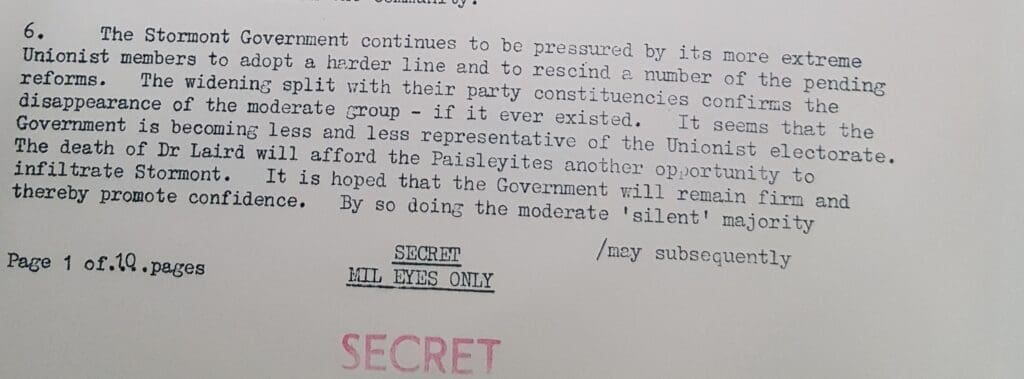

History books have since posited that this attack on the Ferguson home as the work of the UVF. The British Army recognised this immediately at the time as a continuation of the targeted wave of UVF attacks throughout the first half of April. When the house of another Unionist was attacked with dynamite on 24 May in Carrickfergus, the British Army INTSUM for the period (compiled by Lt. Hughes for the Brigade Commander this time) recorded:
“This attack smacks of the bombing of the former Lisburn-based MP Richard Ferguson, on 28 April, who spoke out against PUP electoral gains, (Rev Beattie). Both attacks are attributed to the UPV/UVF”
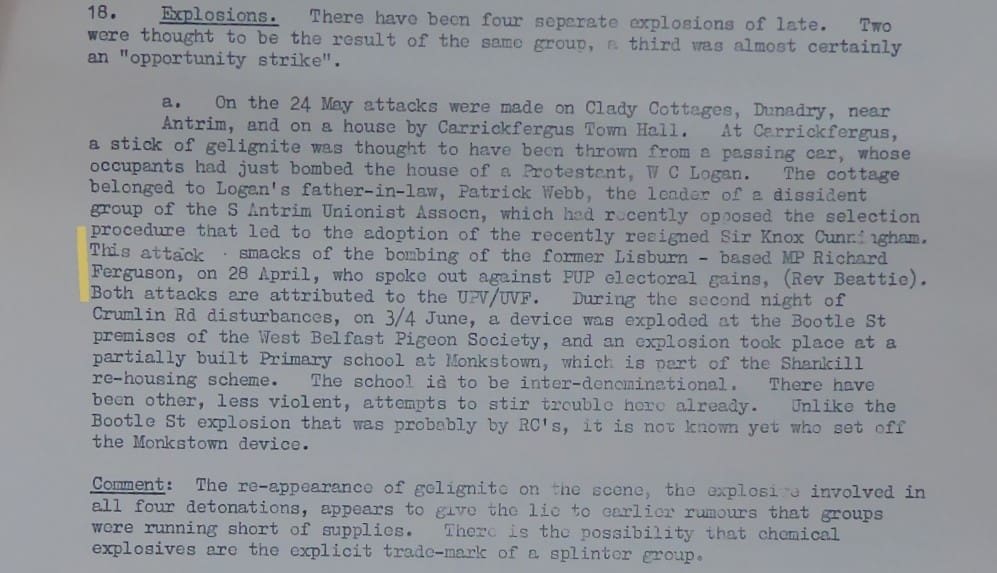
Reading the secret British Military Intelligence summaries today, the wave of alleged UVF false flag bomb attacks in 1970 were just as historic as those in 1969 which blew O’Neill out of office. They may have even been more successful as they not only helped blow Paisley into office, but they remained hidden for 55 years.
Paisley won O’Neill’s old seat and then secured a seat at the British Houses of Parliament in June 1970. Until then, it appears that the UVF was actually the greatest destabilising paramilitary organisation to the Ulster Unionist ruling party and not the IRA, although the UVF deliberately stoked those fears, and the British armed forces failed to inform the public that these fears were manufactured.
So, history was made in April 1970, but we still had the opportunity to row back from violence and offer equal rights to all citizens. That opportunity may have disappeared within weeks following the Battle of St. Matthews and the Falls Curfew. The hardliners won, and we dug in for a war that lasted a generation.
The wave of bombing and false flag attacks also began a pattern of wilful collusion and cover-up of Loyalist paramilitary violence by the British Armed Forces and a capitulation by Ulster Unionist politicians to Loyalist threats. The media remained stenographers for the state. This all continued, of course, throughout the conflict, but was most evident just before internment in August 1971. The British Army had provided the names of around 80 alleged Protestant extremists to be included in the original swoop, but the Northern Ireland government and RUC demanded that they be taken off, and they were indeed.
Instead, the highly discriminatory internment policy was directed solely against the Irish Catholic community until February 1973 by which time Loyalist extremists had murdered around 120 Irish Catholic civilians, including 15 civilians in the McGurk’s Bar Massacre. The British Armed Forces not only covered up for the UVF bombers of McGurk’s Bar but also disappeared evidence and blamed the innocent civilians in the bar. One of the dead was my own grandmother, Kathleen Irvine.
Ian Paisley, of course, went on to have a long and history-making career in politics that ended in his term as First Minister in a devolved, power-sharing Stormont from 2007–2008. Nevertheless, we will be arguing about his negative or positive impact on Northern Ireland society throughout his journey from sectarian fundamentalist and civil rights opponent until his Damascene conversion to power-sharing with Republicans in 2007. His change of heart was too much for the political party and church he created and he was unceremoniously dumped by them both a year later.
Hopefully, students of history will learn more about his close connections with militant Loyalist paramilitarism, as it did not end with the UPV/UVF in 1970. Paisley helped set up Third Force in 1981 and Ulster Resistance in 1986; and Ulster Resistance’s weapons – smuggled into Ireland with the help of the British intelligence services – were not decommissioned and can be used whenever it suits this next generation of hardliners.
They haven’t gone away, you know.
